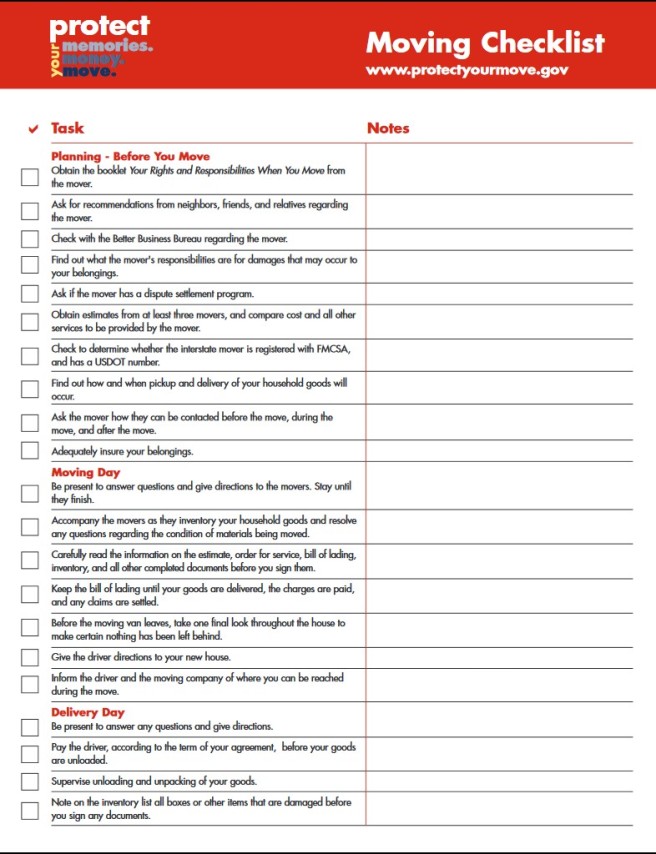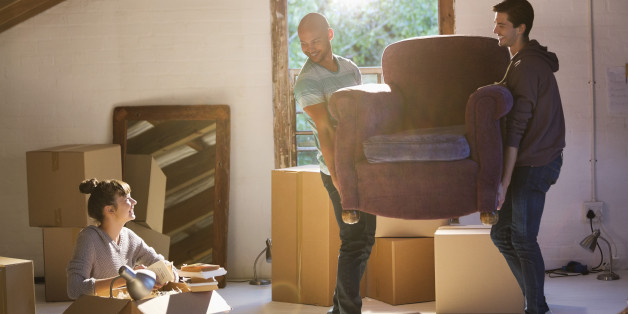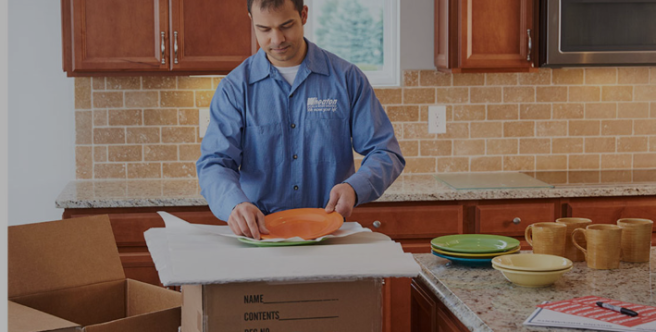![]()
We Can Help!
![]()

![]()




Children are experts at taking emotional cues. Looking or sounding sad (or fearful of the looming tantrum) will trigger a lot of stress in their little heads. At the same time, over-the-top enthusiasm will likely confuse your child. They will undoubtedly experience some negative emotions, so acting if those don’t or shouldn’t exist will also tie them up in knots. Acknowledge the downsides, but emphasize – early and often – the positive things you can all look forward to.
And some places nearby, like parks, playgrounds and pizza parlors. Make plans to go out and explore, using Google maps and Google Earth to help make your new home come to life in their heads.
Help them understand all their complicated feelings about the move. Here are three good ones:
Count off each day as it passes. Not with big black X’s – those are no fun and arguably intimidating. Instead, let your child put a sticker on each day that passes. Let them put extra stickers on the days they helped with the things in part two.
 Ask your children what they’d like to do with the boxes.
Ask your children what they’d like to do with the boxes.Do this right when you get them all unpacked at your new home. Show them some possibilities like these to spark their imaginations. Then let them mark each box they think they’ll want to use – with a circle or some kind of “secret symbol” so no one forgets.
This is for all the things they want to take with them on the car ride to your new home. Let them draw all over it (and the rest of their boxes too.) Just explain that whatever they take has to fit in that box. Make sure to help them with the difficult choices that are sure to come!
Protip: Your child might not even open that chest during the trip from old house to new. Just knowing all their most prized possessions are still with them (somewhere in the back of the crowded car) may be enough to keep them feeling secure. But they’ll still want something to do for however many hours (or days?) until you are in your new home and the movers show up with the rest of your world. Fill their backpack with books, paper and crayons, small toys and whatever else you or they decide would be fun to have. Don’t have a backpack yet? There may never be a better time then now.
Invite grandma over for some quality time. Have a few playdates with their friends – preferably at those friends’ homes! This not only takes their mind off the move for a while, but it takes them off your hands so you can get things done. You’ll need the time. (Trust us!)
Ask them to open the door to each bedroom, bathroom and closet when it’s time to show the movers around. Tell them passing out bottles of water or paper plates for the pizza is an important job that will need to be done. Or spur their imaginations by explaining the upstairs hallway and the pathways to the front door are going to be the movers’ runways, and it would be great if they could make sure everyone keeps them clear on…
Their bedroom is a good and obvious choice, as this might be the place they’ll feel most secure when the rest of the house is being cleared out. (Remind them not to go running out onto the runway without peeking out their door first, to make sure no “airplanes” are coming.) You also may need to rotate them out if they are the kind of child who doesn’t want to be couped up all day. (And who does?)

Protip: You probably won’t want to add to your load right before your move, but think about getting something new for them to have with them in their private space. Something as simple (and compact) as a Nerf basketball hoop or a stuffed animal or a new DVD works great and can help keep them happy and busy, while also serving as an early start to their new life in their new home.
By this point, any fridge you have will be empty and defrosted. So it’s a great idea to have plenty of food and drink on hand, for move day and for the trip to your new home. But you are also going to be without a fridge and a stove for a while, which can be challenging if you don’t want your child eating Happy Meals all day. Hit the supermarket for minimum preparation food items – cereal, yogurt and fruit, sandwiches and veggies and, of course, cookies! And then get something special for dinner, like pizza. Or, okay, a Happy Meal.
Protip: Paper plates and cups are super-convenient when you are on the road, but consider bringing your child’s favorite cereal bowl, dinner plate and cup (with a spill-proof top) in the car to add a sense of comfort and continuity. Just because your child is not saying anything through their mouthful of pepperoni doesn’t mean everything’s cool in their world.
This gives your child as much time as possible in their little private world, but it also means their things will be coming off the truck first at your new home. Imagine how happy – and important – that will make your child feel as you…

Ask your child where they think the TV should go. Help them arrange their bedroom, and talk about how they can decorate it. Imagine all the fun things you’ll be able to do in the family room, the basement and the yard. Heck, remind them that there are runways in this house too!
Take some time instead to help your child get accustomed to their new surroundings. Go for a walk together. Meet the neighbors. Find that park or playground. Get ice-cream. At the end of the day, make sure they feel safe and secure – and happy – in their new room. The rest of the house may still be a sea of cardboard and shrink-wrapped furniture, but making your child feel like they truly are at home has to be priority one.
Finally, and most importantly, remember our first point: As hectic and challenging the process of moving can be, your positive attitude will cue your child into the idea that despite the downsides, you all have plenty of positives to look forward to. And that works for adults, too.
Let’s face it: Moving days are never easy. After all, no one looks forward to lifting heavy boxes in and out of trucks, up and down stairs. However, moving day doesn’t have to be completely chaotic, either. All it takes is a little planning and forethought to make the day run smoothly.
With that in mind, we decided to go straight to the source. We asked pro movers to share their best advice on how to accomplish a painless move. Incorporate some of these moving tips into your packing plan to help this would-be-stressful process go off without a hitch.
“If you’re hoping to get a better rate on a moving company or rental truck, avoid scheduling your move on weekends or at the end of the month. These companies are usually slower during the week/mid-month and are willing to give deals,” says Ryan Carrigan, co-founder of moveBuddha.
“If you’re hiring a moving company, try to book the earliest morning time slot available. The moving crew will be fresh, so they’ll typically get the job done more efficiently.”
“Most people know that they’ll need plenty of boxes, packing tape and bubble wrap for the move. However, shrink wrap can be your best friend when it comes to moving,” advises Tieece Gordon of Affordable Removals. “Take furniture, for example – it may be expensive, but it’s also fragile. Drawers and doors on wardrobes, dressers, etc. can also be securely fastened shut using this cost-effective material. Plus, it never hurts to buy more of everything than you think you’ll need.”
“Don’t just start boxing up everything in sight,” says Kelly Tenny, Content and Social Media Manager with Zippboxx. “Pack up your belongings in a strategic manner. Go room-by-room and begin by packing up items that you do not use very often, like décor and accessories. Leave the things that you use frequently for last. This will save you time scouring boxes you already packed for that one item you need!”
“Be careful not to pack boxes that are too heavy,” suggests Emil Perushanov, owner of Top Removals. “Not only will they be a literal pain for your movers on moving day, but they’ll be difficult for you to move around while packing.”
As for a general rule? “Try to stick to a 30-pound limit for each box and, when packing heavier items like books, use smaller boxes. This will keep you from overloading.”
Kate Windleton, Relocations Manager at Strong Move, recommends planning ahead when it comes to appliances. “Your fridge needs to be defrosted at least a day earlier. Your washing machine, your oven, etc. should be turned off, cleaned and, if possible, put in their original boxes. Secure their cords and seal their doors so they don’t open accidentally while inside of the truck.”
Have you moved recently? What moving tips can you share from your experience? Tell us in the comments.

Get rid of the things that you don’t want or need a few weeks before you plan to move — including the old furniture you intend to replace, the clothes you’ll never wear again and the kitchen items you rarely use. One great way to unload your unwanted belongings for a small profit is to hold a yard sale. Other ways to sell your stuff include:
Donate the stuff you can’t sell to secondhand stores and throw the stuff you can’t donate away. Whatever you do, DON’T try to hold onto something in the hopes of selling or donating it at a later date (unless it’s a major antique or valuable family heirloom).
If you’re moving out of an apartment, you can probably DIY your move. But if you live in a large single-story or multi-level home, you’re better off hiring movers. Hiring movers doesn’t have to entail extravagant costs and extras; in fact, there’s a good chance you can find a local moving company within your budget. Remember, you want to get everything to your new home in one piece — preferably in the least amount of time required.
When shopping or comparing local companies, you need to get at least three quotes, just like you would any other local service. You can also negotiate with movers, depending on how close their quotes are in price. This is especially true in the offseason, between fall and winter, when they’re most likely to lower their rates.
Never buy packing supplies from a moving truck rental store. Get boxes from friends and family members if you can. If not, buy boxes from local home improvement stores. Some websites also sell packing supplies at an affordable rate.
Moving shouldn’t have to be stressful, expensive and time-consuming. By preparing, finding ways to save money and planning appropriately, you can make a smooth transition from your old to new home while keeping your sanity intact.
At 1st Choice Movers, we are completely dedicated to customer satisfaction, which is why we employ the most dependable and professional movers. Our Jacksonville moving company provides you with comprehensive packing and moving services. When you have an upcoming interstate move that originates in one state and ends in another, it can be very stressful on you and your family. 
Each color of duct tape should indicate a room or “zone” in the house. Assign each room in your house a color. For instance, all my kitchen boxes received a red piece of duct tape. After I finished packing a box with kitchen items, I would put a piece of red duct tape somewhere on one of the four sides of the box. Do not put it on the top, that doesn’t help when all the boxes are stacked a mile high in the moving van or shipping container. Put it on one of the sides so you will see at first glance.
As a trusted Jacksonville moving company, we go to great lengths to protect the integrity of your items by packing similar items together and ensuring everything is properly padded. It is our goal to help you save time during the lengthy moving process. If you would like our assistance with packing before your move, call usnow at (904) 731-7223!